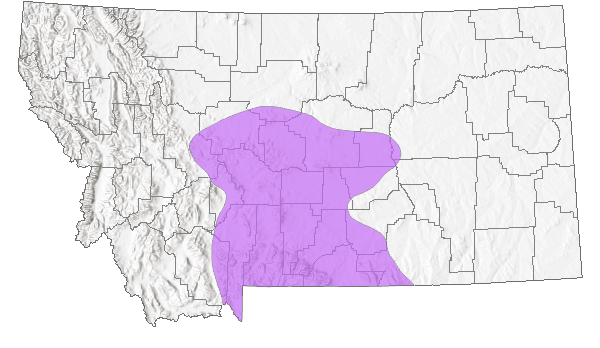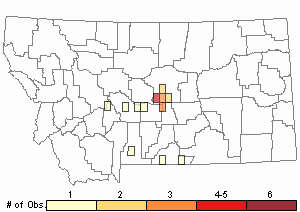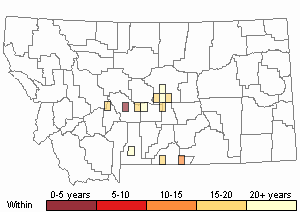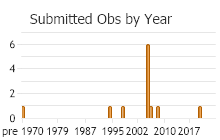View in other NatureServe Network Field Guides
NatureServe
Montana
Utah
Wyoming
Idaho
Wisconsin
British Columbia
South Carolina
Yukon
California
New York
Berry's Mountainsnail - Oreohelix strigosa berryi
General Description
Shell is low-domed heliciform, 7-13 mm diameter (types 9.3 and 9.4 mm), height of types 6.1 and 6.3 mm. Color cinnamon to snuff brown, from third whorl profusely marked with white patches and narrow streaks; last whorl having a chocolate band below the periphery. Shell surface is somewhat wrinkled and shows traces of spiral striation in places. Shell to about 4.4 whorls, all convex. Embryonic shell of nearly 2 whorls, which are finely striate and covered with very fine spirals, the last half of the second whorl having distinct spiral striae. Umbilicus narrow, contained 5.5 times in the diameter of the shell (Pilsbry 1939; Frest and Johannes 1993; Burke 2013). Internal anatomy described by Pilsbry (1939).
Phenology
Active in wet and cool weather; otherwise not described.
Diagnostic Characteristics
Small size (< 13.0 mm diameter), range and habitat separates this species from most other Oreohelix in Montana. Similar in size and appearance, as well as range and habitat, to Oreohelix pygmaea but with weaker growth wrinkles and spiral striae, lower spire (not bee-hived shape) and a smaller umbilicus (Burke 2013).
Species Range
Montana Range
Range Descriptions

 Native
Native
Range Comments
Oreohelix strigosa berryi is documented from several locations in and near the Big Snowy Mountains of Fergus and Golden Valley counties, Montana, and more recently (P. Hendricks unpublished data) from the Judith Mountains, also in Fergus County, and the vicinity of Montanopolis in the Absaroka Mountains, Park County (Frest and Johannes 1995); elevation ranges from 1295-2438 m (4250-8000 ft). Also documented in Wyoming in Yellowstone National Park near Mammoth (Henderson 1933, 1936; Pilsbry 1939) and in the Black Hills National Forest of Wyoming and South Dakota (Frest and Johannes 1993).
Observations in Montana Natural Heritage Program Database
Number of Observations: 22
(Click on the following maps and charts to see full sized version)
Map Help and Descriptions
Relative Density

Recency



 (Observations spanning multiple months or years are excluded from time charts)
(Observations spanning multiple months or years are excluded from time charts)
Migration
Sedentary.
Habitat
Found among small loose rock, shrubbery, and under Creeping Juniper (Juniperus horizontalis) on west-facing canyon slopes at the type locality in the Big Snowy Mountains, and under sticks and logs in moister locations in the same mountain range (Berry 1916). This snail was present in the Mammoth area of Yellowstone National Park on a north exposure of limey soil with plenty of cover, but neither very wet nor dry (Henderson 1936). Substrate typically is derived from limestone (Frest and Johannes 1993, 1995). In the Black Hills and Bear Lodge Mountains of Wyoming and South Dakota, it occurs in mixed and open Ponderosa Pine (Pinus ponderosa) forests with relatively thin litter, often with aspen (Populus tremuloides) and birch (Betula) in the canopy, and violets (Viola) and Bunchberry Dogwood (Cornus canadensis) in the understory (Frest and Johannes 1993); the deciduous tree component was relatively important for the occurrence of this subspecies.
Food Habits
Feeds on deciduous tree components (Frest and Johannes 1993).
Ecology
Oreohelix strigosa berryi in Montana has been fully documented only in the Big Snowy Mountains. Population sizes are not reported for any of the Montana locations, nor have most of these sites been revisited in recent decades. Berry (1916) found it to be the most conspicuous land snail near the mouth of Swimming Woman Creek Canyon in the Big Snowy Mountains. Colonies outside of the Big Snowy Mountains generally appear to be small and isolated (Frest and Johannes 1993), although the recent collection of shells in the Judith Mountains (P. Hendricks unpublished data) indicates colonies, some fairly large, may be present in some of the other "island mountains ranges" of eastern Montana. Henderson (1936) said the species occurred in abundance near Mammoth in Yellowstone National Park, Wyoming. Population trends are unknown for any locality.
Colony lengths of a mile and widths of 1/4-1/2 mile are known from several states.
Reproductive Characteristics
Most individuals breed once, but under extremely wet conditions, young could be released twice in the same year (Frest and Johannes 1993). In many cases, breeding takes place in October-November or by April-May, and young are shed in May-June or September-October. The young hatch internally and can be retained in the adult for some time after internal hatching; this unusual ability is believed to be an adaptation for xeric living conditions. Growth to adulthood commonly requires just under one year (Frest 1991).
Management
The type locality (Swimming Woman Creek Canyon) and all other known locations (six total) in the Big Snowy Mountains are on lands administered by the Musselshell Ranger District of the Lewis and Clark National Forest. Two other sites north of the Big Snowy Mountains apparently are on private and possibly state land. The site in the Judith Mountains is on land administered by the Lewistown Field Office of the Bureau of Land Management. The Park County site is on land administered by the Livingston Ranger District of the Gallatin National Forest.
Stewardship Responsibility
Threats or Limiting Factors
Habitats occupied by Oreohelix strigosa berryi are may be threatened by logging and grazing, and possibly weed control and mining, but most documented localities have not been revisited in decades, so current threats are unknown. Fire and fire suppression efforts could have negative impacts (numerous dead shells found in the Judith Mountains were in a decade-old burn). Logging and grazing threaten the Black Hills National Forest colonies (Frest and Johannes 1993). Habitat requirements and food habits are poorly understood. Colonies may be local and small.
References
- Literature Cited AboveLegend:
 View Online Publication
View Online Publication Berry, S.S. 1916. Notes of Mollusca of central Montana. Nautilus 29:124-128.
Berry, S.S. 1916. Notes of Mollusca of central Montana. Nautilus 29:124-128. Burke, T. E. 2013. Land snails and slugs of the Pacific Northwest. Corvallis, OR: Oregon State University Press. 344 p.
Burke, T. E. 2013. Land snails and slugs of the Pacific Northwest. Corvallis, OR: Oregon State University Press. 344 p. Frest, T. J. 1991. Survey of Spearfish Canyon and vicinity, Black Hills, South Dakota and Wyoming for Oreohelix strigosa cooperi (Binney, 1858) and associated land snails. Deixis Consultants for USDA Forest Service. 59 pp.
Frest, T. J. 1991. Survey of Spearfish Canyon and vicinity, Black Hills, South Dakota and Wyoming for Oreohelix strigosa cooperi (Binney, 1858) and associated land snails. Deixis Consultants for USDA Forest Service. 59 pp. Frest, T. J. and E. J. Johannes. 1993. Land snail survey of the Black Hills National Forest, South Dakota and Wyoming. Deixis Consultants, Seattle, WA. 278 pp.
Frest, T. J. and E. J. Johannes. 1993. Land snail survey of the Black Hills National Forest, South Dakota and Wyoming. Deixis Consultants, Seattle, WA. 278 pp. Frest, T.J. and E.J. Johannes. 1995. Interior Columbia Basin mollusk species of special concern. Final report to the Interior Columbia Basin Ecosystem Management Project, Walla Walla, WA. Contract #43-0E00-4-9112. 274 pp. plus appendices.
Frest, T.J. and E.J. Johannes. 1995. Interior Columbia Basin mollusk species of special concern. Final report to the Interior Columbia Basin Ecosystem Management Project, Walla Walla, WA. Contract #43-0E00-4-9112. 274 pp. plus appendices. Henderson, J. 1933. Mollusca of the Yellowstone Park, Teton Park and Jackson Hole region. Nautilus 47:1-3.
Henderson, J. 1933. Mollusca of the Yellowstone Park, Teton Park and Jackson Hole region. Nautilus 47:1-3. Henderson, J. 1936. Mollusca of Colorado, Utah, Montana, Idaho, and Wyoming, supplement. University of Colorado Studies 23(2): 81-145.
Henderson, J. 1936. Mollusca of Colorado, Utah, Montana, Idaho, and Wyoming, supplement. University of Colorado Studies 23(2): 81-145. Pilsbry, H.A. 1939. Land Mollusca of North America (north of Mexico.) George W. Carpenter Fund for the Encouragement of Original Scientific Research, Philadelphia, Pennsylvania. 2107 pp.
Pilsbry, H.A. 1939. Land Mollusca of North America (north of Mexico.) George W. Carpenter Fund for the Encouragement of Original Scientific Research, Philadelphia, Pennsylvania. 2107 pp.
- Web Search Engines for Articles on "Berry's Mountainsnail"
- Additional Sources of Information Related to "Snails / Slugs"





